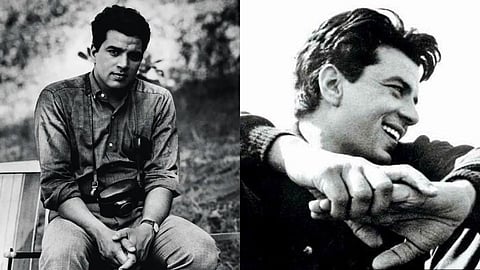
- HOMEGROWN WORLD
- #HGCREATORS
- #HGEXPLORE
- #HGVOICES
- #HGSHOP
- CAREERS
- ABOUT US
- CONTACT US

Dharmendra (1935–2025), one of Indian cinema’s most beloved superstars, leaves behind a vast yet under-appreciated legacy spanning nearly 250 films across six decades. From his striking performances in Satyakam, Bandini, Anupama, and Sholay, to his understated contributions to social-realist cinema, Dharmendra embodied a rare blend of screen charisma and naturalistic craft. His rugged good looks and effortless charm often led critics to overlook his depth, even as he delivered some of Indian cinema’s most enduring characters. Rooted in the Indo-Persian literary tradition and shaped by Partition-era Punjab, Dharmendra’s passing invites a deeper recognition of an actor who combined poetic sensitivity with mainstream appeal. He died on November 24, 2025.
A thespian of nearly 250 films over more than six decades, Dharmendra’s cinematic legacy is a fascinating study in paradox: he was a performer of immense popularity, reliability, and versatility whose naturalistic acting was perpetually overshadowed by his dazzling looks and effortless charm. From the tragic idealist in 'Satyakam' (1969) to the charming rogue in 'Sholay' (1975), Dharmendra Kewal Krishan Deol — better known by his mononym Dharmendra — delivered some of Indian cinema’s most enduring characters. Yet, the fact that he never won a Filmfare Best Actor award for an individual performance remains the most poignant testament to his under-recognised range as a master of his craft.
Sadly, the biggest obstacle to Dharmendra’s critical acclaim was the very quality that made him stand out from his cohort: his conventional, rugged good looks and effortless, masculine charm that earned him the moniker of Bollywood’s “He-Man”.
Critics and audiences alike conflated his easy screen presence with a lack of effort in his performances. His appeal was so natural — a blend of raw, Punjabi machismo and innate romanticism — that his acting was often seen as simply an extension of his personality, rather than a skill crafted through rigour. This stands in stark contrast to his contemporaries, such as Amitabh Bachchan and Sanjeev Kumar, whose unconventional appearances were often cited as evidence of their reliance on dramatic ability.
Dharmendra, on the other hand, made brilliance seem too effortless, especially in the 1960s and early 1970s, taking on roles no other male actor at the time could or would accept. In film after film — from 'Bandini' (1963) to 'Phool aur Patthar' (1966), and 'Anpadh' (1962) to 'Mamta' (1966) — he was willing to play second fiddle to more established actresses like Nutan, Mala Sinha, Meena Kumari, and Suchitra Sen.
During this period, Dharmendra anchored a series of profoundly moving, socially rooted films, often collaborating with directors like Bimal Roy (Bandini) and Hrishikesh Mukherjee (Satyakam, Chupke Chupke). Whether he was playing the sensitive poet in 'Anupama' (1966) or the morally conflicted doctor in 'Bandini', Dharmendra excelled in roles demanding stoic suffering and moral complexity.
He carried forward the mantle of social realism at a time when much of Hindi cinema was embracing lighter, hedonistic themes, setting him apart as a mature, reliable actor-hero. In 'Satyakam' (1969), widely regarded as his finest dramatic performance, he embodied an engineer of unyielding moral integrity, forcing audiences to grapple with complex themes of idealism versus corruption in a nation in transition. Take, for example, one of his final scenes in the film, where Dharmendra’s Satyaprakash, speechless on his deathbed, wordlessly expresses so much without a single line of dialogue.
This phase of social realism was inevitably disrupted by the shift to a more hedonistic mainstream Indian cinema in the 1970s. With the emergence of Amitabh Bachchan and the “Angry Young Man” persona, which mirrored the disillusionment of the era, the market favoured brooding rebellion over Dharmendra’s idealism and romantic flair. While he successfully pivoted to the action and comedy genres, notably with his iconic portrayal of Veeru in 'Sholay' (1975) and the brilliant comic timing of 'Chupke Chupke' (1975), this versatility ironically further fractured his critical perception. He became so fluent in different genres that he was categorised as the “reliable star” rather than a “great actor”. Much like Robert Redford, Brad Pitt, and Colin Farrell in Hollywood, Dharmendra was a character actor trapped in his own leading-man looks.
Beyond the silver screen, Dharmendra’s enduring legacy rests on his role as the last actor-hero of a generation deeply connected to the Indo-Persian literary and dramatic tradition of undivided India. Hailing from pre-Partition Punjab, he was fluent in both Hindi and Urdu, a linguistic fluidity that informed the delivery and lyricism of his dialogue. Furthermore, his personal experience of the Partition of India — though less outwardly dramatic than contemporaries like Muhammad Yusuf Khan, better known as Dilip Kumar — shaped his foundational worldview.
This heritage contributed to his unique screen persona: a rugged man of the soil whose raw strength was tempered by an underlying poetic soul and profound humility, making him one of the most reliable, versatile, and, ultimately, under-recognised actor-heroes of Indian cinema. His belated Filmfare Lifetime Achievement Award, received in 1997, served less as a crowning achievement and more as an institutional acknowledgement of a career that deserved far more nuanced appreciation. Dharmendra passed away on Monday, November 24, 2025, at the age of 89.
